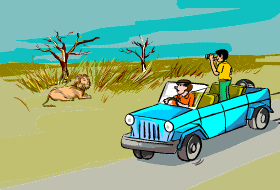Even now when my father takes a deep hacking cough in the middle of the night I am startled from my sleep, for I imagine the deep-throated ‘uuuunnnhhhh’ of the lioness as she ambled across the track without taking her eyes from our jeep.
I was at my brother’s place at Rajkot in Gujarat, spending a much-needed break from the claustrophobic confines of Mumbai. The change of scene had made me so mellow that I readily acquiesced to my 10-year-old nephew, Anant’s order disguised as a plea to pay a visit to Sasan Gir to see the Asiatic lions.
On second thoughts it seemed a great idea, for I, too, had never seen a lion in its natural habitat.
Two days later we clambered aboard my brother’s Jeep to drive down to the Sasan Gir Lion sanctuary, at a distance of 150 km by road. The nearest airport is at Keshod which is about 70 km away, while trains run daily from Sasan Gir to Veraval and Junagadh (65 km), and Delwada (to connect to Diu). Buses ply between Junagadh and Veraval and Sasan Gir through the day.
First Sighting of Gir
We went in December, which was good timing. December to April is the best time for a visit; the sanctuary is closed between June and October during the monsoon.
Gir is dusty brown, dry and thorny, exactly resembling the African wild you see in films. It is not the lush landscape that one had imagined, though nearly seven rivers flow through it. But this harsh landscape assumes a sombre grandeur when you realise that it is the last bastion of this large and majesctic jungle cat.

Walking on the Wild Side [Illustration by Anup Singh]
The reason was that they were hunted for sport, said the boy in a disapproving manner, adding that when they were precariously close to extinction, efforts at conservation were started by the former nawabs of Junagadh. The lions now survive in this secluded corner sharing their habitat with local villagers and their cattle!
Getting around
At the Sinh Sadan forest lodge office we were issued a permit for entry. Our Jeep was to get a two-day rest for private vehicles are not allowed to be driven in the park.
The choice was between an official matador, mini bus and Jeep so we chose the latter, for it can access the smaller trails, thus increasing the chances of spotting a lion. Walking is a strict no-no.
A night in the wild
Something happens when you stay in these environs. Things start looking much simpler and you can think of life on the planet as a combination of the sky, earth forest and water – and you. Exactly how a four year-old draws a picture of the sun, mountains, a river, a hut and she.
And it is so easy to huddle inside the blankets with a 10 year-old and experience all the little creaks, grunts and growls that sounded from the great darkness in the night.
In the morning, order is restored somewhat with sunlight, though the heart thumps at the thought of seeing a huge feline with an amber coat within a few feet of oneself!
The safari
The next day morning we presented ourselves for the safari and were told that the lions are elusive, but one had to be really unlucky not to spot one during the safari. The guides and drivers know every waterhole and in the early morning you can almost certainly spot a loner or a pride ambling across.
Most of them are familiar with the sight of humans gawking at them and since there is no threat perception, it is possible to drive in fairly close. At best they give a warning cough and more often than not, they are bored and yawn, showing yellowing canines.
We were lucky. Barely had the Jeep stopped at a waterhole when the guide motioned us to silence, and pointed at a bramble bush. All we could see was a rust brown thorny bush about the level of a man’s head when suddenly, a lioness stepped out, standing barely 10 feet away from us.
After eyeing us for a full minute (it seemed more like an hour) she majestically crossed to the other side to be instantly swallowed by the bush!
“See how the animals camouflage themselves in the forest,” shrieked Anand. And then we realised that we had not kept our camera ready in all that excitement. We took several photographs of the sambar and chital and a variety of birds, from shrikes and barbets to fishing eagles. The lioness was destined to be a part of our memory.
In the afternoon we went to the crocodile-breeding farm at Sasan, where crocodile hatchlings are released into their natural habitat. In the evening, those of us who had spotted a lion, walked tall, while the deprived ones looked at us enviously. But the look in their eyes seemed to say, “Well, tomorrow is another day, and we’ll get even. Just you wait.”
Anant and I exchanged a meaningful look and smiled. We made a good team and promised to travel to repeat the trip in six months time, combining it with a visit to Somnath (site of one of the 12 jyotirlingas) about 45 km from Sasan Gir.










